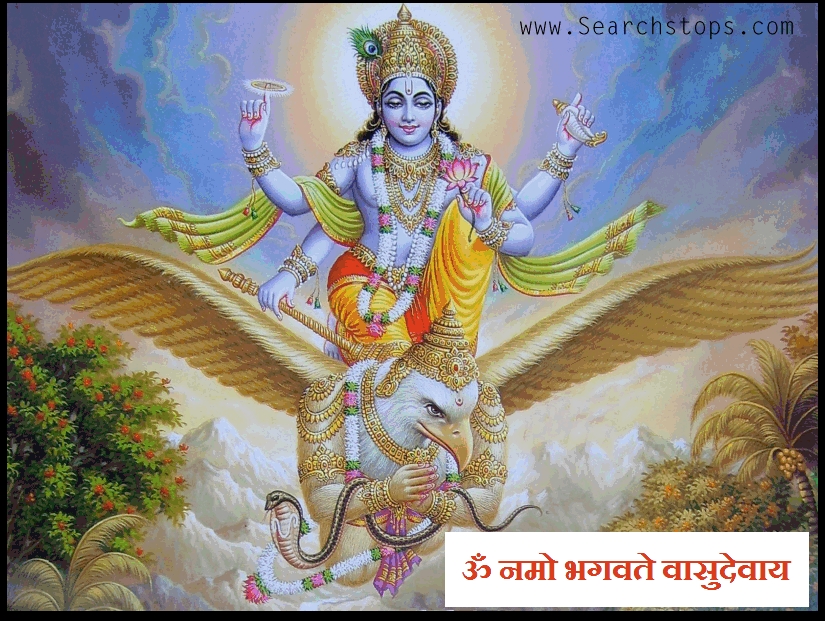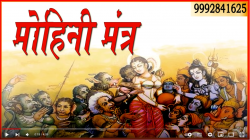Download Here
Om Namo Bhagavate Vasudevaya (in devanagari: ॐ नमो भगवते वासुदेवाय) is a Hindu mantra. ‘Om Namo Bhagavate Vasudevaya’ is a mantra ofVishnu and Krishna both. It has two traditions—Tantric and Puranic. In Tantrik Tradition, the Rishi of the Mantra is Prajapati, in Puranic Tradition the Rishi is Narada. Both, however, say it is the Supreme Vishnu Mantra. Sharada Tilak Tantram, for example, says “Dvadasharno mahamantrah pradhano Vaishnavagame”—the twelve lettered mantra is the chief among vaishnava mantras. Similarly, this is the ultimate mantra in ShrimadBhagavatam, whose 12 Chapters are taken as extensions of the 12 Letters of this Mantra., This twelve syllable mantra is known as a Mukti (liberation) mantra and a spiritual formula for attaining freedom.This can be chanted like Gayatri Mantra. This is the principal mantra of the Vedic scripture “Srimad Bhagavatam”. This mantra can also be found in Vishnu Purana.
Many of you, as spiritual seekers, would be practicing japa sadhana. When you were initiated you would have been told that you should do japa, chanting of the Divine Name. Tat japah jadarthabhavanah – the recitation, chanting or japa of the mantra is to be accompanied by a contemplation on its importance or meaning. As a matter of fact, japa, according to Patanjali, is not merely a mechanical chanting of the Name, although chanting is also Japa, but it is tadartha bhavana or the contemplation on the meaning of the mantra. To give an instance, ‘Om Namo Bhagavate Vaasudevaya’ is a mantra. Chanting this is japa. Japa can be of two kinds: external verbaljapa, as well as internal manasika japa, or mental japa. Japa is the repetition of a mantra, which is a mysterious group of letters or phrases so connected with one another that when the mantra is chanted a peculiar sensation or vibration is generated in the entire system. That is the difference between ordinary words or sentences or groups of phrases and a mantra. A mantra is the result of a vision of a seer and it is the concrete manifestation of the deity or devata through the world of language, which is made to manifest in the mantra. When you chant a mantra correctly and systematically with proper intonation, there is immediately set up a vibration in the nervous system in such a manner that a harmony is established in the whole world. Different mantras produce different vibrations and they invoke different devatas.
‘Om Namo Bhagavate Vasudevaya‘ is a mantra of Bhagavan Sri Krishna. It means literally: “Prostration to Bhagavan Vasudeva.” ‘Surrender to Sri Vasudeva’ is implied therein. Now, the prostration, salutation, is an external symbol of the internal union. When we do namaskara to a deity in the temple, to a friend or any person, we join both the palms and bend ourselves low. Thisnamaskara, and the joining of the palms are indicative of the feeling of union of oneself with the other. “I and you are one” – that is prostration, that is namaskara. “Bhagavan Vasudeva, I am one with you” is a spirit of surrender, and here begins meditation on Bhagavan Vasudeva. When this mantra is chanted you have also created the requisite atmosphere in the mind for contemplation on Bhagavan Vasudeva, to begin meditation and to feel His presence. This rule applies to all other mantras, also.
Most of you will have this practical difficulty when the mantra is chanted and meditation begins. The mind ordinarily gets confused as to how to start, what to begin with, what to think, what to feel, etc. When you chant a mantra you may think of the letters of the mantra. Perhaps you may also feel that the meaning of the mantra is “prostration to Bhagavan”. But how are you to proceed further? Mentally, feel that the Lord is seated or standing in front of you, and slowly, after an adequate length of time or period, you will begin to feel His omnipresence in front of you, to the right and to the left, above and below, and so on.
The thought of God is like a fire which will burn up all desires. The highest knowledge is nothing but the deep feeling of the presence of God everywhere. That is the highest wisdom and that will give a deathblow to the desires of the world. The desire for God is a desire to destroy all desires. It is not a desire in the ordinary sense of the term. As a single matchstick can reduce to ashes a huge mountain of straw, so too a single thought of the omnipresence of God, the immanence of God and the omnipotence of God is enough to burn up all desires pertaining to this world, because God is the fulfillment of our aspirations and when we feel His presence, there need be no other desire. When we have the ocean we do not want a drop, for the drops are in the ocean. A single moment of honest, genuine deep thought of God is greater than the performance of several asvamedhasacrifices, agnihotmas, rajasuyas and so on. It is the highestsacrifice, the highest yajna and the greatest truth. All sadhanas lead to this goal of meditation, and this spiritual‑consciousness which is the center and the path of all meditation, should animate all your activities in life. In one sense, you should be in a meditative mood always. I think this is what Bhagavan Sri Krishna means in the gospel of the Bhagavadgita.
Though life appears to be very complicated, it would become very simple, a joyous process when you practise japa sadhana. The more you practise, the greater the strength it will give you. Yesterday’s practice will give you additional strength to practise today, and today’s will give you strength tomorrow. Every day you will become stronger and stronger by profounder thoughts of God and deeper contemplation on Him. There is no loss of merit in the practice, says the Bhagavadgita. Even a little that you have done is great indeed and it is a wonderful asset which will help you in the future. May the Almighty Lord give you strength to do more and more japa sadhana.





